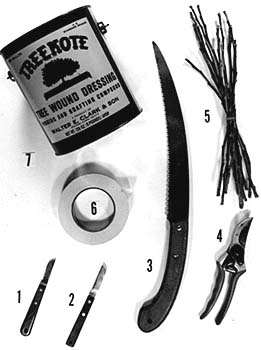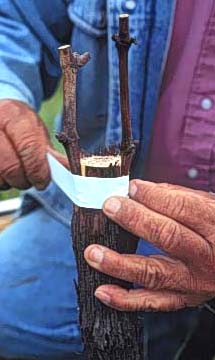
Grafting supplies
 My
topworking this past spring failed miserably. I think part of that
was user error and environmental factors beyond my control, but another
big part of the problem was lack of proper tools. So I decided to
weigh the odds in my favor this winter by buying proper equipment and
supplies.
My
topworking this past spring failed miserably. I think part of that
was user error and environmental factors beyond my control, but another
big part of the problem was lack of proper tools. So I decided to
weigh the odds in my favor this winter by buying proper equipment and
supplies.
The most essential tool
for grafting is a quality knife. It should be edged on one side
and flat on the other, and should be of high enough quality metal that
you can sharpen it on a stone. If you get into more complicated
types of grafting, you may also want to get a budding knife (curved on
the tip), surgical knives (for herbaceous plants), and cleaving tools,
mallets, and wedges for topworking, but most of us can skip
those. However, you will probably want to have normal pruning
tools and a lower quality knife on hand so you don't ruin your grafting
knife by cutting bindings or preparing branches.
The next item you'll
need is some kind of sealant (along with a brush --- half an inch wide
by three quarters of an inch long). In The
Grafter's Handbook,
Garner mentions all kinds of old fashioned recipes made out of some
subset of clay, fresh horse manure, hay, hair, wax, resin, and more,
but I suspect it's worth spending a few dollars to take advantage of
modern technology. Phillips recommends Trowbridge's
grafting wax
(although it needs heat to liquify), Doc Farwell's latex grafting
compound, or Treekote.
 Finally, you will want some
kind of binding material. During Garner's era, grafters tied the
scionwood to the rootstock with raffia, pieces cut from inner tubes,
rubber bands, plastic strips, sheets of rubber covered in tinfoil (for
herbaceous plants), or cotton twine dipped in wax. They sealed
larger areas with cotton sheets dipped in grafting wax or beeswax,
counting on the weak cloth to tear as the tree grew. Phillips
recommends electrical tape or parafilm (both of which have to be
removed in one or two months, as did many of Garner's materials), or rubber
grafting strips (which grow with the twig).
Finally, you will want some
kind of binding material. During Garner's era, grafters tied the
scionwood to the rootstock with raffia, pieces cut from inner tubes,
rubber bands, plastic strips, sheets of rubber covered in tinfoil (for
herbaceous plants), or cotton twine dipped in wax. They sealed
larger areas with cotton sheets dipped in grafting wax or beeswax,
counting on the weak cloth to tear as the tree grew. Phillips
recommends electrical tape or parafilm (both of which have to be
removed in one or two months, as did many of Garner's materials), or rubber
grafting strips (which grow with the twig).
I went ahead and bought
a Victorinox
Florist's Grafting Knife, which has a cheap plastic
casing but good reviews for the low price. But I haven't decided
what to do about sealant and binding material, so I'd be very curious
to hear from other grafters out there. What do you use?
| This post is part of our Grafting lunchtime series.
Read all of the entries: |
Want more in-depth information? Browse through our books.
Or explore more posts by date or by subject.
About us: Anna Hess and Mark Hamilton spent over a decade living self-sufficiently in the mountains of Virginia before moving north to start over from scratch in the foothills of Ohio. They've experimented with permaculture, no-till gardening, trailersteading, home-based microbusinesses and much more, writing about their adventures in both blogs and books.
Want to be notified when new comments are posted on this page? Click on the RSS button after you add a comment to subscribe to the comment feed, or simply check the box beside "email replies to me" while writing your comment.

Victorinox uses stainless steel for its blades. In general, stainless steel is relatively soft and won't hold an edge as well as e.g. carbon steel or tool steel. OTOH, it doesn't corrode easily. But you have to clean it after use anyway; the sap from the tree might foul the mechanism.
If you want a super sharp knife for detail work, better get a surgeon's blade handle with the differerent kinds of interchangeble blades. Fair warning though; these things are wickedly sharp.
Roland --- The author specifically suggests surgeon's knives, but only for vegetative plants (not for woody ones like fruit trees). I suspect that maybe the surgeon's knives just aren't tough enough for wood?
Chris --- Thanks for linking to that ebook --- it looks right up my alley! I suspect there are different brands of grafting tape, with some biodegradable and some not. It looks like the one you linked to definitely is!
The blades of surgeon's knives are thin, and use steel alloys that are hard (but relatively brittle) to retain their sharpness well. So they can shatter if you don't handle them correctly, like pressing hard on the blades out-of-plane.
I've used them extensively to cut open silicon rubber castings used as molds for casting plastics. Silicon rubber is very tough, but those blades cut it with ease.
My biggest worry is always not to slip and cut myself, because of how darned sharp they are.
In the grafting class I took this spring we used masking tape it worked really well and broke as the trees grew.
One thing I found was make sure you make the tape TIGHT around the tree to help the graft grow well in the normal plane of growth
I have been grafting for ~25 years and have owned and used both stainless steel and carbon steel knives. In my experience stainless steel is harder than carbon steel. Because of it's hardness, it's more difficult to put a very sharp edge on stainless and you probably can't get it quite as sharp as a carbon steel blade. Also because of it's hardness, stainless steel dulls less quickly. Carbon steel, being softer, is easier to sharpen but requires frequent re-sharpening to maintain a good edge. Carbon steel also requires more careful cleaning and oiling to keep it from pitting. Our group (MidFEx) teaches grafting in the Chicago area each spring. We sell Victorinox knives to novice grafters because they are pretty sharp out of the box obviating sharpening and are otherwise low maintenance tools. We have several very experienced grafters that prefer their carbon steel blades for the superior edge they can put on them and are willing to do (or enjoy doing) the extra sharpening and cleaning.